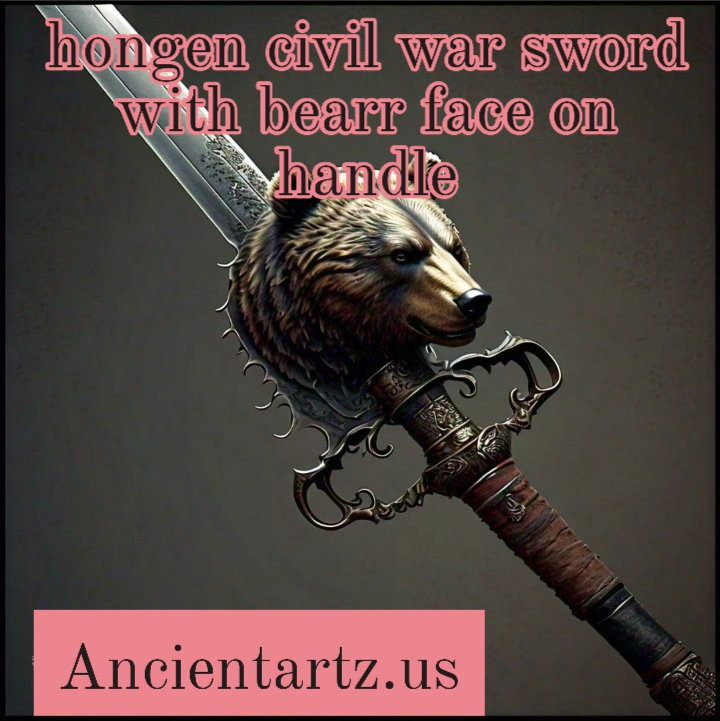Introduction
The Hongen Civil War Sword is a captivating artifact from China’s rich military history. This sword, which dates back to the tumultuous period of the Taiping Rebellion (1850–1864), carries with it stories of power, honor, and sacrifice. But beyond its sharp blade and historical significance, the sword is particularly known for its distinctive handle, which is sculpted in the shape of a bear’s face. This unique design adds an element of mystery and cultural importance to the sword, making it a fascinating object for collectors, historians, and enthusiasts of ancient Chinese warfare.
In this article, we will delve into the details of the Hongen Civil War Sword, exploring its historical context, the symbolism behind the bear face on the handle, and its role in the Taiping Rebellion. We will also explore how this sword has evolved over time, its cultural significance, and why it remains a subject of fascination today.
The Hongen Civil War Sword: A Historical Overview
The Hongen Civil War Sword is often associated with the Taiping Rebellion, one of the largest and most destructive civil wars in Chinese history. The rebellion, led by Hong Xiuquan, a self-proclaimed brother of Jesus Christ, aimed to overthrow the Qing Dynasty and establish the Taiping Heavenly Kingdom. The war caused millions of deaths and had a profound impact on China’s political, social, and cultural landscape.
The Role of Swords in the Taiping Rebellion
During this period, swords were more than just weapons; they were symbols of power, authority, and leadership. Military leaders and warriors would carry elaborately designed swords, which were often personalized to reflect their status and beliefs. The Hongen Civil War Sword is believed to have been one such weapon, carried by a high-ranking officer or general of the Taiping forces. The sword’s design, craftsmanship, and the symbolic nature of its handle were meant to inspire fear in enemies and instill confidence in allies.
The Significance of the Bear Face
The most striking feature of the Hongen Civil War Sword is the bear face sculpted into the handle. While there are various interpretations of this design, it is generally believed that the bear represents strength, courage, and resilience—qualities highly valued during times of war. In Chinese culture, the bear is not only seen as a symbol of physical might but also as a creature that protects its territory and family. These characteristics would have been ideal traits for a military leader or warrior fighting in a rebellion as violent and fierce as the Taiping War.
Additionally, the bear’s face on the sword’s handle may have been intended to evoke a sense of fear in enemies. The face is carved with a fierce expression, giving the weapon an intimidating presence on the battlefield. This design reflects the Chinese belief in the power of symbols and their influence over the physical world.
Materials and Craftsmanship
The Hongen Civil War Sword is made from high-quality steel, as was typical for weapons of its era. The blade is long, curved, and designed for slashing attacks, which would have been effective in close combat during the chaos of battle. The sword’s handle, where the bear’s face is featured, is often crafted from wood, metal, or bone, and sometimes decorated with intricate patterns or inscriptions. The craftsmanship of this sword reflects the skill of the artisans of the time, who were able to combine function with form to create a weapon that was both deadly and symbolic.
The Hongen Sword in Context: The Taiping Rebellion and Its Aftermath
The Taiping Rebellion was a period marked by extreme violence and political upheaval. The Qing Dynasty was severely weakened, and the region was divided into territories controlled by the Taiping forces and the Imperial government. This conflict was one of the bloodiest civil wars in history, resulting in the deaths of millions and leaving lasting scars on China’s social and political fabric.
The Role of the Hongen Sword in the Rebellion
As an emblem of power, the Hongen Civil War Sword would have been carried by one of the key figures in the Taiping army. Its presence on the battlefield would have signified not just the martial prowess of the person carrying it, but also their leadership and dedication to the Taiping cause. The sword could have been used in critical battles, helping to define the outcome of some of the most important engagements of the war.
Given its association with the rebellion, the sword represents the complex nature of the conflict. While it was a tool for violence, it also held a cultural and symbolic value. It was a reminder of the ideals of the Taiping movement, which sought to reform Chinese society through radical religious and social change.
Post-Rebellion Legacy
After the fall of the Taiping Heavenly Kingdom in 1864, many of the artifacts associated with the rebellion were either destroyed or hidden away. The Hongen Civil War Sword, however, managed to survive as a relic from this period of intense struggle. Its continued existence today serves as a testament to the legacy of the Taiping Rebellion, and it is often displayed in museums or private collections to educate people about this critical moment in Chinese history.
The Bear Face Symbolism: What Does It Mean?
The bear face on the handle of the Hongen Civil War Sword is not just a random artistic feature. It holds deep cultural and symbolic significance. Let’s explore some of the interpretations of this design:
Strength and Courage
In Chinese culture, animals are often associated with specific virtues. The bear, in particular, symbolizes strength, bravery, and tenacity. A bear’s fierce nature and its ability to protect its cubs were likely traits that were admired in a warrior, especially one involved in a brutal civil war. The bear face on the sword serves as a reminder of the physical and mental strength needed to survive and lead in such a hostile environment.
Protection and Defense
The bear is also a symbol of protection. In many cultures, the bear is seen as a guardian figure, fiercely defending its territory from intruders. This symbolism may have been intended to reflect the role of the Taiping warriors, who were defending their new kingdom against the forces of the Qing Dynasty. The sword, with its bear-shaped handle, could have represented the idea of a protector—someone who stood firm in the face of danger.
Fear and Intimidation
Finally, the bear’s face is fierce and intimidating, evoking fear in potential enemies. The design of the sword was likely meant to strike terror into the hearts of the opposition. In ancient warfare, the appearance of a weapon or its wielder could have a psychological effect on the enemy, and the fearsome bear face would certainly contribute to that.
Conclusion
The Hongen Civil War Sword is more than just a weapon; it is a cultural and historical artifact that embodies the spirit of the Taiping Rebellion. The sword’s unique design, featuring a bear face on the handle, symbolizes strength, courage, and protection—qualities that were vital in the brutal struggles of the time. This remarkable sword offers a glimpse into China’s past and serves as a reminder of the fierce determination of those who fought in one of the largest civil wars in history.
Today, the Hongen Civil War Sword is not just a relic of the past but a valuable piece of historical art. It continues to intrigue historians, collectors, and anyone interested in understanding the complex nature of Chinese warfare and symbolism. The combination of artistry, functionality, and meaning embedded in this weapon ensures that it remains a symbol of the turbulent and transformative era of the Taiping Rebellion.
FAQs
1. What is the Hongen Civil War Sword?
The Hongen Civil War Sword is a weapon from the period of the Taiping Rebellion in China, famous for its unique handle carved in the shape of a bear’s face. It is a symbol of strength, courage, and protection.
2. What does the bear face on the handle symbolize?
The bear face represents strength, protection, and fear. In Chinese culture, bears are seen as guardians and symbols of courage, which were qualities essential during the Taiping Rebellion.
3. Who would have used the Hongen Civil War Sword?
The sword would likely have been used by high-ranking officers or generals within the Taiping army, who fought against the Qing Dynasty during the Taiping Rebellion.
4. Why is the Hongen Civil War Sword significant?
It is significant because it represents the ideals of the Taiping Rebellion, a major event in Chinese history. The sword’s design and symbolism make it a key cultural and historical artifact.
5. Where can I see the Hongen Civil War Sword today?
The sword is typically held in private collections or displayed in museums, where it is studied and admired for its historical and artistic value.


